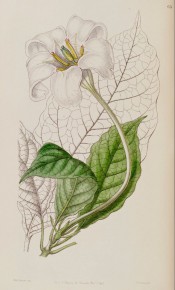Euclinia longiflora Salisb.
Frost-tender shrub or small tree, sometimes scrambling, with oblong leaves, to 30cm, and solitary, terminal, white to cream or pale yellow, funnel-shaped flowers, tinged red at the tips. To 6m. [RHSD].
Horticultural & Botanical History
‘A handsome stove plant, discovered in the year 1815 by Mr. Allan Cunningham and Mr. Bowie the King’s Botanical Collectors, in Brazil, and by them sent to the Royal Gardens at Kew. I am indebted to Mr. Aiton for the fine specimen here figured. The Genus must remain doubtful, until we have the opportunity of examining the fruit. Mr. Cunningham observes the ovary to have “two cells, and each cell to contain many ovules, which appear evidently to indicate that the seeds in the mature fruit are enveloped in a soft pulp;” and he agrees with me in thinking that for the present, it is best referred to Randia.’ [BM t.3409/1835]. The plant figured and described here as Randia bowieana is now considered to be Euclinia longiflora Salisb. and a comparison of the figure in Curtis’s Botanical Magazine with that of Gardenia devoniana in the Botanical Register shows near identical plants. However Euclinia longiflora is a tropical African species and I have found no reference to it growing in tropical South America.
‘This glorious plant [Gardenia devoniana] is a native of Sierra Leone, whence living specimens were imported by Mr. Whitfield. It is, perhaps, the finest of its noble race, and is, we trust, worthy of the name which we have ventured to confer upon it. Handsome as Lord Derby’s Gardenia certainly is, it is as far removed from this as an earldom from a dukedom. The flowers are nearly eleven inches long, pure white at first, but after a time changing to a light straw colour, and look much like those of a huge white lily.’ [BR f.63/1846].
‘[The Duke of Devonshire’s Gardenia is] the finest Gardenia yet seen, infinitely superior to G. Stanleyana, to which it is related.’ The foliage is dark blue-green when mature. The large, solitary, terminal flowers are white at first but gradually change to pale yellow. ‘At first they look something like a long-tubed white lily.’ [Gard. Chron. 1846]. ‘Beautiful evergreen shrubs, bearing such noble flowers as these Gardenias do, cannot fail of becoming universal favourites; and lest it may be thought they require too much room for culturists generally to think of growing them, we may again state, comparatively small plants bloom.’ [MB p.267/1846]. Introduced to Britain in 1845. [JD]. FC p.266/1847. FS pl.X 1re Liv./1847.
History at Camden Park
Listed in the 1857 catalogue only [T.503/1857]. It was requested of Kew Gardens on 1st February, 1849 [MP A2933-1, p.177] and of John Lindley at the London Horticultural Society on 1st February, 1849 [MP A2933-1, p.182a]. Either of these could be the source.
Notes
Published Feb 07, 2010 - 05:03 PM | Last updated Aug 13, 2010 - 12:12 PM
| Family | Rubiaceae |
|---|---|
| Category | |
| Region of origin | Tropical Africa |
| Synonyms |
|
| Common Name | Tree gardenia, Angel?s trumpets |
| Name in the Camden Park Record |
Gardenia Devoniana |
| Confidence level | high |
